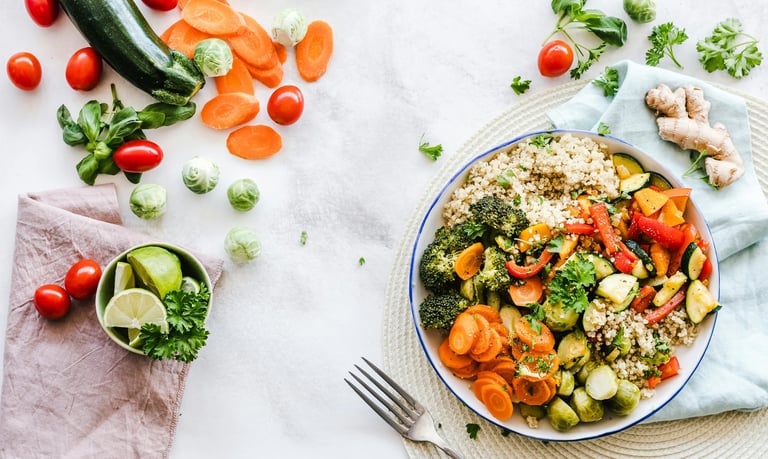The Longevity Trick Hiding in Your Salad Bowl
HEALTH & WELLNESSEDITOR'S PICKS


Variety, it turns out, could be the missing piece in the longevity puzzle.
For decades, we’ve been told to eat more fruits and vegetables. It’s solid advice, but the latest research adds a compelling twist: it’s not just about how many plant-based foods you eat, but how many different kinds make it onto your plate. Variety, it turns out, could be the missing piece in the longevity puzzle.
A recently published 2025 study hints at something quietly revolutionary. Those who regularly consumed a diverse mix of plant-based foods rich in naturally occurring compounds called flavonoids appeared to enjoy lower risks of chronic illness and premature death. The concept is gaining ground across wellness cultures, many of which already prioritize variety in everyday meals. This is also quite evident in various Blue Zones around the world, where longevity is as much about joy and curiosity as it is about what’s on the plate.
What are flavonoids and why should you care?
Flavonoids are natural plant compounds found in richly colored foods like berries, dark leafy greens, herbs, tea, and even dark chocolate. These compounds have been linked to a variety of health benefits, largely because of their role as antioxidants found in plants. They help neutralize free radicals, reduce inflammation, and support cellular health.
What makes them truly interesting is not their presence in a single food, but the cumulative power they offer across a broad, colorful diet. So, instead of sticking to a daily spinach routine, think of weaving in beet greens, parsley, red cabbage, or dandelion. Blueberries are great, but so are blackcurrants, cherries, and blood oranges. You may already know a lot about eating clean. Now, it’s time to eat more expansively.
The hidden power of variety
One of the more intriguing developments in nutritional science is a shift away from sheer quantity and toward diversity. A 2025 study published in Nature Food tracked the diets and health outcomes of over 120,000 participants across several years. The results? Those who ate a broader array of flavonoid-rich foods had significantly lower rates of major chronic diseases and a reduced risk of early death, even when the total amount of fruits and vegetables they ate was similar to others.
This discovery is part of a growing body of research connecting dietary variety to robust health. A 2022 study published in The American Journal of Clinical Nutrition found that a more diverse diet supported a healthier metabolism and gut microbiome. People who incorporated a wider range of plant-based foods into their meals showed signs of better nutrient absorption, improved digestion, and more resilient immune function.
So what does this mean for your next meal? It’s not about perfection or hitting a target number of plant foods. It’s about opening the fridge or scanning a market shelf and choosing something different every so often. Swap your usual romaine for bitter greens or mustard leaves. Add a handful of pomegranate seeds to your breakfast or roast purple carrots alongside the orange ones. Diversity doesn’t have to be dramatic. Just deliberate.
How to eat vibrantly
Making room for variety doesn’t have to be overwhelming. Start small and build naturally. Here are four thoughtful ways to upgrade your everyday meals:
Color-code your plate
A quick glance at your meal should reveal four to five distinct colors. This visual shorthand can guide you toward variety without any measuring. A quinoa salad with cherry tomatoes, shredded purple cabbage, cucumber, and scallions is one example. So is a West African peanut stew brightened with spinach and bell peppers. According to the American Heart Association, color variety helps you benefit from different nutrients found in different hues.
Mix up your greens
Spinach is a classic, but there’s a world of greens waiting to be used. Rotate in arugula, watercress, beet greens, dandelion, and herbs like parsley or cilantro. Even swapping out one type of green for another in a soup or stir-fry adds another note to your nutritional symphony. The Ikarian chickpea lemon soup becomes something else entirely with a handful of wild greens stirred in.
Pair unlikely flavors
Let your palate travel. Layer sweet with sharp, earthy with acidic. Add orange slices to a roasted beet salad. Swirl cocoa into a berry compote. Toss chopped apples with mint and flat-leaf parsley. Unexpected flavor combinations can keep meals exciting and help you integrate new produce without overthinking.
Try new ingredients
Culinary diversity often comes built-in with global cuisines. Ingredients like turmeric, fermented soy, miso, and edamame are packed with flavor and nutritional depth. Try a bowl of roasted vegetables with a peanut butter and miso glaze, or spice your chia seed pudding with cardamom and cinnamon. These ingredients reflect traditions that prioritize balance, depth, and variety.
There is no single superfood, no secret supplement. What appears to support longevity most is a pattern of eating that celebrates range and rhythm. A colorful plate reflects a curious mind, and a curious mind tends to be a well-nourished one. Health, as always, is about more than just food. But when it comes to building a plate that supports vitality from the inside out, eating vibrantly may be one of the simplest and most powerful habits you can adopt.
